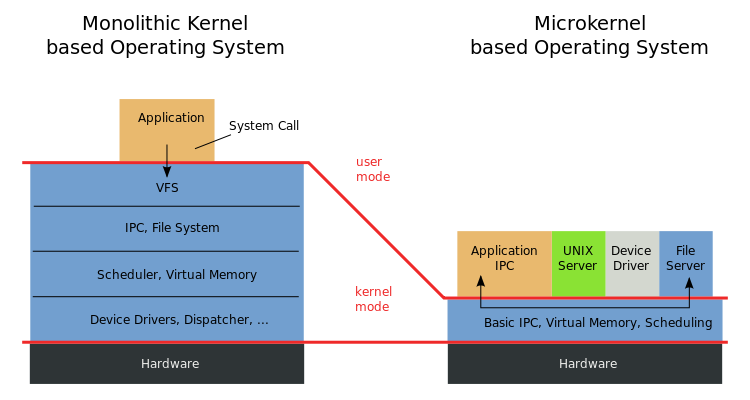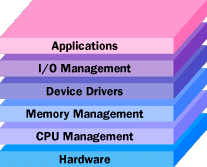Types and Understandings of Operating System Architecture
I’m going to write about the many forms of operating system architecture and their contents. There are several kinds of operating systems. Most people are familiar with the monolithic operating systems Windows and Linux, however embedded operating systems frequently employ hierarchical or micro operating systems. I believe this will be very useful for students and scholars, and queries are always welcome.
What is the subject of this article?
- Monolithic Operating System
- Microkernel Operating System
- Differences between monolithic and microkernel operating systems.
- Hierarchical Operating System
- Other Operating Systems
Modern operating systems are extremely complicated because they provide numerous services and support a wide range of hardware and software resources. Researchers in operating system design overcome this complexity by constructing operating system components and defining the execution rights of each component. All operating system components are included in the kernel in a monolithic design, while just the essential components are included in a microkernel design to maximize stability.
Monolithic Operating System
It is the most frequent operating system architecture produced in the early phases, and it incorporates all kernel components. It can connect directly with other components via simple function calls, making inter-component communication more efficient. However, it is difficult to determine the source of defects or other mistakes, making it less stable. Furthermore, because all code has complete access to the system, monolithic kernel systems are vulnerable to faults, malicious code, or hackers.
Microkernel Operating System
A microkernel operating system design reduces kernel size, increases scalability, and delivers just necessary functions. Low-level memory management, interprocess communication, and basic synchronization capabilities for inter-process cooperation are typical services featured in this design.
Most operating system components, including as process management, network, file system interaction, and device management, function outside the kernel via user permissions under this approach. The microkernel’s highly modularized design enables excellent scalability, portability, and scalability.
Furthermore, because it does not rely on each component for execution, a failure or fault in one or two components will not result in the entire operating system being disabled. This modularization, however, results in a trade-off between module connectivity and performance.
Differences between monolithic and microkernel operating systems.
Monolithic operating system kernels feature a single huge kernel of code that provides all system services and all operating system functions. Monolithic kernels operate at a privileged layer of the system, putting them closer to the computer’s hardware. Linux and Unix are two operating systems that employ a monolithic kernel.

Microkernel operating system designs, on the other hand, are meant to be minimalistic, with a tiny kernel that offers just the basic functions required by the operating system. User-space processes provide additional capabilities and services. Microkernels are hence smaller and use fewer resources than monolithic kernels. MacOS and QNX are two operating systems that employ microkernel architecture.
Hierarchical Operating System
Handling pure monolithic architectures got increasingly challenging as operating systems grew bigger and more complicated. A hierarchical approach to the operating system was proposed to tackle this problem. The hierarchical method organizes parts that perform comparable duties into groups, and each group is divided into hierarchies that interact only with the hierarchy immediately above and below it.
The lower hierarchy serves the top hierarchy while concealing specific implementations. A hierarchical operating system can be modularized more effectively than a monolithic operating system. Modularity enables fault-tolerant self-contained components to be reused throughout the system.

Other Operating Systems
Network operating systems, distributed operating systems, hypervisor operating systems, Hybrid operating systems, Nanokernel operating systems, Cluster operating systems, and many more are examples of architectures.
A Network Operating System (NOS) is an operating system that is built particularly to deliver network services to client computers on a network. A network operating system’s principal job is to provide file, print, database, application, messaging, authentication, directory, and security services across the network. A NOS is often placed on a server and is in charge of controlling network access to shared resources. It facilitates communication between networked devices and services by utilizing multiple protocols such as TCP/IP and DHCP.
Windows Server, Unix, and Linux are examples of network operating systems. These operating systems offer a variety of network-centric features such as file sharing, printer sharing, a DNS server, a web server, an email server, a database server, and so on. A NOS centralizes network administration and management, making it easier for network administrators to govern and monitor the network. The NOS also includes security capabilities such as authentication and encryption, which aid in the protection of the network against potential assaults or security breaches.
The features of both monolithic and microkernel architectures are combined in hybrid architecture, with the microkernel handling the functions of the monolithic kernel. This design has the benefit of being more reliable than a monolithic kernel and performing better than a microkernel. The Windows NT series of operating systems is an example of a hybrid architecture-based operating system.
The nanokernel architecture is a more streamlined version of the microkernel architecture that only delivers modest and basic functionalities. As a consequence, it has a high level of security and performance. Google’s Fuchsia OS is an example of an operating system that employs nanokernel architecture.
A cluster operating system architecture is one in which numerous computers each have an operating system installed and function as a single system. Each computer has its own operating system instance, but from the standpoint of the user, it functions as a single computer system. This design is capable of providing high availability as well as load balancing. Beowulf cluster and Oracle RAC are two examples.
The hypervisor (also known as virtual machine) architecture is based on virtualization technology and allows several independent operating system instances to run on a single physical system. A virtual machine can run many operating system instances. VMWare, VirtualBox, and Hyper-V are a few examples.
All Links for Operating System
1. Before You Begin with Operating Systems
2. What is the history of operating systems and specifically what tasks do they perform?
3. Will the missions and tasks of operating systems expand in the future?
4. Basic Concepts Needed to Understand Operating Systems
5. About Operating System Process Life Cycle
6. How is Operating System Process Management done?
7. How can we increase the processing speed of operating system processes?
8. What is an Operating System Thread?
9. How does Operating System Scheduling work?
10. Is there a criterion for comparing OS Scheduling Algorithms?
11. What is Process Synchronization in OS?
12. What is a Semaphore in Operating Systems?
13. (Memory Management) How do you manage operating system memory?
14. How is the OS Memory Partitioned?
15. What is OS Virtual Memory?
16. What is the relationship between Page Table Entry, and page in/out, swapping in the operating system?
17. What are the basic concepts of OS memory?
18. Operating System Page Replacement Algorithm
19. About Operating System File Systems
20. What is the internal structure of the file system in the operating system?
21. OS disk space allocation techniques and effective algorithm criteria?
22. What is Access time, Disk scheduling algorithm, and I/O system in the OS file system?
23. Types and Understandings of Operating System Architecture
